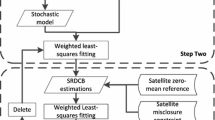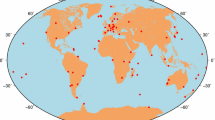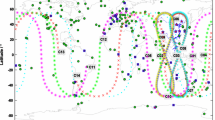Abstract
With the development of Low Earth Orbit satellites, differential code biases (DCBs) estimation based on onboard observations has been widely studied. In this study, onboard observations of BDS and GPS satellites by the Chinese Fengyun-3D (FY-3D) and Fengyun-3C (FY-3C) satellites are applied to estimate BDS and GPS DCBs. Since only the code observations of C1C and C2W for GPS, and C2I and C7I for BDS are tracked by FY-3D and FY-3C, the DCB types of GPS C1C-C2W and BDS C2I-C7I are estimated with code multipath considered. First, the DCB estimates based on FY-3D onboard observations are analyzed. When jointly processing BDS + GPS onboard observations, the stability of satellite and receiver DCBs for both BDS and GPS has better consistency with the DCB products of the German Aerospace Center (DLR) and the Chinese Academy of Science than that for the single-system solutions (BDS-only solution and GPS-only solution). This is reasonable because more onboard observations are used in BDS + GPS solution, which can improve the strength of the DCB estimation. The variations of receiver DCB are analyzed as a function of geomagnetism and solar activity, but little relationship between them has been found. Compared with the FY-3C solution, the FY-3D solution can achieve a more stable satellite DCB with a stability improvement of 33%, 48%, 62% and 56% for GPS, BDS GEO, IGSO, and MEO satellites, respectively. Meanwhile, the receiver DCB of FY-3D is more stable than that of FY-3C as well. These improvements of satellite and receiver DCBs can be due to the enhancement of FY-3D GNSS Occultation Sounder (GNOS) instrument, which provides more observations with higher quality. Furthermore, both FY-3D and FY-3C onboard observations are processed together to estimate BDS and GPS DCBs. Compared with the FY-3D solution, the stability of satellite DCB can be improved by 16%, 9% and 7% for GPS, BDS GEO and IGSO satellites DCB, respectively, when both FY-3D and FY-3C onboard observations are jointly processed. The impact of DCB estimation on estimating the vertical total electron content (VTEC) is also investigated. Compared with FY-3D GPS-only and BDS + GPS solutions, the VTEC estimates along the FY-3D orbit can achieve more realistic results for FY-3D + FY-3C solution.













Similar content being viewed by others
References
Bai W, Sun Y, Du Q, Yang G, Yang Z, Zhang P, Bi Y, Wang X, Cheng C, Han Y (2014) An introduction to the FY3 GNOS instrument and mountain-top tests. Atmos Meas Tech 7(6):1817–1823. https://doi.org/10.5194/amt-7-1817-2014
Blewitt G (1990) An automatic editing algorithm for GPS data. Geophys Res Lett 17(3):199–202. https://doi.org/10.1029/GL017i003p00199
Cai Y, Bai W, Wang X et al (2017) In-orbit performance of GNOS on-board FY3-C and the enhancements for FY3-D satellite. Adv Space Res 60(12):2812–2821. https://doi.org/10.1016/j.asr.2017.05.001
Foelsche U, Kirchengast G (2002) A simple ‘‘geometric’’ mapping function for the hydrostatic delay at radio frequencies and assessment of its performance. Geophys Res Lett 29(10):1473. https://doi.org/10.1029/2001GL013744
Hernandez-Pajares M, Juan JM, Sanz J (1999) New approaches in global ionospheric determination using ground GPS data. J Atmos Sol Terr Phys 61(16):1237–1247. https://doi.org/10.1016/S1364-6826(99)00054-1
Li M, Li W, Shi C, Jiang K, Guo X, Dai X, Meng X, Yang Z, Yang G, Liao M (2017a) Precise orbit determination of the Fengyun-3C satellite using onboard GPS and BDS observations. J Geodesy 91(11):1313–1327. https://doi.org/10.1007/s00190-017-1027-9
Li W, Li M, Shi C, Fang R, Zhao Q, Meng X, Yang G, Bai W (2017b) GPS and BeiDou differential code bias estimation using Fengyun-3C satellite onboard GNSS observations. Remote Sens 9(12):1239. https://doi.org/10.3390/rs9121239
Li X, Li X, Yuan Y, Zhang K, Zhang X, Wickert J (2018a) Multi-GNSS phase delay estimation and PPP ambiguity resolution: GPS, BDS, GLONASS, Galileo. J Geodesy 92(6):579–608. https://doi.org/10.1007/s00190-017-1081-3
Li X, Xie W, Huang J, Ma T, Zhang X, Yuan Y (2018b) Estimation and analysis of differential code biases for BDS3/BDS2 using iGMAS and MGEX observations. J Geodesy. https://doi.org/10.1007/s00190-018-1170-y
Lin J, Yue X, Zhao S (2016) Estimation and analysis of GPS satellite DCB based on LEO observations. GPS Solut 20(2):251–258. https://doi.org/10.1007/s10291-014-0433-1
Mannucci AJ, Wilson BD, Yuan DN, Ho CH, Lindqwister UJ, Runge TF (1998) A global mapping technique for GPS-derived ionospheric total electron content measurements. Radio Sci 33(3):565–582. https://doi.org/10.1029/97RS02707
Montenbruck O, Kroes R (2003) In-flight performance analysis of the CHAMP BlackJack GPS receiver. GPS Solut 7(2):74–86. https://doi.org/10.1007/s10291-003-0055-5
Montenbruck O, Rizos C, Weber R, Weber G, Neilan R, Hugentobler U (2013) Getting a grip on multi-GNSS-the international GNSS service MGEX campaign. GPS World 24(7):44–49
Montenbruck O, Hauschild A, Steigenberger P (2014) Differential code bias estimation using Multi-GNSS observations and global ionosphere maps. Navigation 61(3):191–201. https://doi.org/10.1002/navi.64
Sanz J, Juan JM, Rovira-Garcia A, González-Casado G (2017) GPS differential code biases determination: methodology and analysis. GPS Solut 21(4):1549–1561. https://doi.org/10.1007/s10291-017-0634-5
Schaer S (1999) Mapping and predicting the earth’s ionosphere using the global positioning system. Ph.D. thesis. Astronomisches Institut, Universität Bern, Switzerland
Wang N, Yuan Y, Li Z, Montenbruck O, Tan B (2016) Determination of differential code biases with multi-GNSS observations. J Geodesy 90(3):209–228. https://doi.org/10.1007/s00190-015-0867-4
Wautelet G, Loyer S, Mercier F, Perosanz F (2017) Computation of GPS P1–P2 differential code biases with Jason-2. GPS Solut 21(4):1619–1631. https://doi.org/10.1007/s10291-017-0638-1
Yang J, Zhang P, Lu N, Yang Z, Shi J, Dong C (2012) Improvements on global meteorological observations from the current Fengyun 3 satellites and beyond. Int J Digit Earth 5(3):251–265. https://doi.org/10.1080/17538947.2012.658666
Yue X, Schreiner WS, Hunt DC, Rocken C, Kuo YH (2011) Quantitative evaluation of the low earth orbit satellite based slant total electron content determination. Space Weather 9(9):S09001. https://doi.org/10.1029/2011SW000687
Zakharenkova I, Cherniak I (2015) How can GOCE and TerraSAR-X contribute to the topside ionosphere and plasmasphere research? Space Weather 13(5):271–285. https://doi.org/10.1002/2015SW001162
Zhong J, Lei J, Dou X, Yue X (2016a) Is the long-term variation of the estimated GPS differential code biases associated with ionospheric variability? GPS Solut 20(3):313–319. https://doi.org/10.1007/s10291-015-0437-5
Zhong J, Lei J, Dou X, Yue X (2016b) Assessment of vertical TEC mapping functions for space-based GNSS observations. GPS Solut 20(3):353–362. https://doi.org/10.1007/s10291-015-0444-6
Acknowledgements
We would like to acknowledge DLR and CAS for providing access to the multi-GNSS products of differential code biases (DCBs). We are very grateful to the reviewers for their helpful remarks for improving this paper. We also sincerely thank Wenjin Yang for her kind support. The numerical calculations in this paper have been done on the supercomputing system in the Supercomputing Center of Wuhan University. This research was funded by the National Natural Science Foundation of China (Grant No. 41774030), the Hubei Province Natural Science Foundation of China (Grant No. 2018CFA081), and the National Youth Thousand Talents Program.
Author information
Authors and Affiliations
Corresponding author
Additional information
Publisher's Note
Springer Nature remains neutral with regard to jurisdictional claims in published maps and institutional affiliations.
Rights and permissions
About this article
Cite this article
Li, X., Ma, T., Xie, W. et al. FY-3D and FY-3C onboard observations for differential code biases estimation. GPS Solut 23, 57 (2019). https://doi.org/10.1007/s10291-019-0850-2
Received:
Accepted:
Published:
DOI: https://doi.org/10.1007/s10291-019-0850-2




